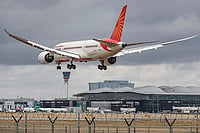India's pioneering space-based solar probe, Aditya-L1, captured an intriguing selfie en route to its destination at Lagrange Point 1 (L1). The craft's onboard camera, on September 4, skillfully framed its largest payload, the Visible Emission Line Coronagraph (VELC), along with the SUIT instruments, adding a dash of celestial charisma to the mission, as reported by the Indian Space and Research Organisation (ISRO). During its four-month journey to L1, this vigilant camera also turned its lens towards Earth and our solitary natural satellite, the Moon, on the second day of its celestial odyssey.
In a whimsical nod to its cosmic observer status, ISRO shared the captivating images along with a playful caption, "👀Onlooker! Aditya-L1, destined for the Sun-Earth L1 point, takes a selfie and images of the Earth and the Moon," via X (formerly Twitter).
Aditya-L1 embarked on its voyage on September 2, launching from Sriharikota in Andhra Pradesh aboard a polar launch satellite vehicle. Achieving a significant milestone on Tuesday, the spacecraft gracefully executed its second Earth-bound maneuver, securing an orbit with dimensions of 282 km x 40225 km.
ISRO officially announced this achievement on 'X,' stating, "Aditya-L1 Mission: The second Earth-bound maneuver (EBN#2) is performed successfully from ISTRAC, Bengaluru. ISTRAC/ISRO's ground stations at Mauritius, Bengaluru, and Port Blair tracked the satellite during this operation. The new orbit attained is 282 km x 40225 km." The next maneuver is scheduled for September 10, approximately at 2:30 am IST.
Aditya-L1 carries seven distinct payloads, each contributing to a comprehensive examination of our Sun. Placing the probe in a halo orbit around Lagrangian Point 1 (L1), situated 1.5 million km away from Earth in the direction of the Sun, is the mission's primary objective. Four of these payloads will scrutinize the Sun's radiance, while the remaining three will measure in-situ parameters related to plasma and magnetic fields.
The mission's overarching goals include delving into the intricacies of the solar corona, its heating mechanisms, solar wind dynamics, solar atmosphere properties, solar wind characteristics, and the genesis of Coronal Mass Ejections (CME) and flares. Additionally, Aditya-L1 will contribute to enhancing our understanding of near-earth space weather, an essential component of space science in the modern era.


























